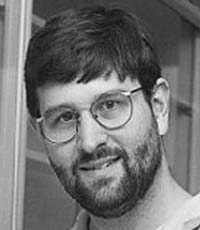Cairns ’87 investigates therapies to cure childhood cancer
Open gallery

Remember the name—Brad Cairns ’87. A rising star in a red-hot research field, Cairns is working on new and innovative therapies to cure childhood cancers.
He pursues that lofty goal as an investigator with the Huntsman Cancer Institute at the University of Utah, where he is also an assistant professor in the Department of Oncological Sciences. His laboratory work focuses on discovering how certain cancers can result when the cellular machines that help express genes go awry.
Breast cancer, many types of leukemia and other soft-tissue cancers can result from errors in the way genes are “packaged,” since their packaging can determine whether or not they are expressed in the cell. Certain mutations in the cellular machinery that packages and unpackages genes also can lead to the formation of aggressive early childhood cancers.
“By knowing how the machine works,” Cairns explains, “we may be able to treat cancers that are caused by mutations in the machine.”
In his search for a link between cancer and how genes are packaged and expressed, Cairns’ research is “in the forefront of his field,” according to Barbara Graves, his program leader at the Huntsman Cancer Institute. Cairns’ cutting-edge research has merited coverage in several scientific journals and a prized appointment as a Howard Hughes Medical Institute investigator.
In May 2000, Cairns, 35, was one of 48 assistant professors nationwide who were selected by the prestigious philanthropy. The recent inductees represent “an incredibly talented group that has begun to make a mark on biomedical research,” says Thomas Cech, the president of the 48-year-old institute.
The HHMI investigator designation isn’t just a nominal honor. On the contrary, Cairns says the financial and organizational support that accompany the designation enable him to pursue “innovative, risky projects” that might not otherwise draw traditional funding.
“You have complete freedom to explore what you think are the most important questions in your field,” he says. “It’s a dream for a scientist.”
Cairns, who graduated with a bachelor’s degree from Lewis & Clark, with honors in chemistry, credits the College for providing an invaluable foundation in the basic sciences.
“The overall science program at Lewis & Clark is really spectacular,” says Cairns. “Not only are the professors great teachers, but they are also dedicated to teaching undergraduates how to do real research.”
He singled out James Duncan, professor of chemistry, for teaching him “rigorous lab technique” and his senior thesis adviser, Janis Lochner, Dr. Robert B. Pamplin, Jr., Professor of Science, for “hooking” him on cell biology.
After graduating from Lewis & Clark, Cairns worked at an Oregon Health Sciences University laboratory for a year, before earning a doctorate in cell biology at Stanford University. There, he isolated the biological machinery that packages and unpackages specific genes in the cell.
Cairns continued his inquiries as a postdoctoral fellow at Harvard University before joining the University of Utah faculty in 1998. In Salt Lake City, he’s found exceptional peers and a wealth of resources.
“Utah is also a great place to live if you like the outdoors,” says Cairns, who enjoys mountain biking in his spare time.
The bulk of Cairns’ attention, however, is devoted to research. His work is already having an impact at the Huntsman Cancer Institute, says Graves. He has joined forces with pediatric oncologists to address the cause of one of the deadliest forms of infant leukemia.
“Bringing Brad’s expertise in gene expression to these important clinical problems,” Graves says, “creates the potential to make extremely important findings.”
—by Dan Sadowsky
More L&C Magazine Stories
Lewis & Clark Magazine is located in McAfee on the Undergraduate Campus.
MSC: 19
email magazine@lclark.edu
voice 503-768-7970
fax 503-768-7969
The L&C Magazine staff welcomes letters and emails from readers about topics covered in the magazine. Correspondence must include your name and location and may be edited.
Lewis & Clark Magazine
Lewis & Clark
615 S. Palatine Hill Road MSC 19
Portland OR 97219

